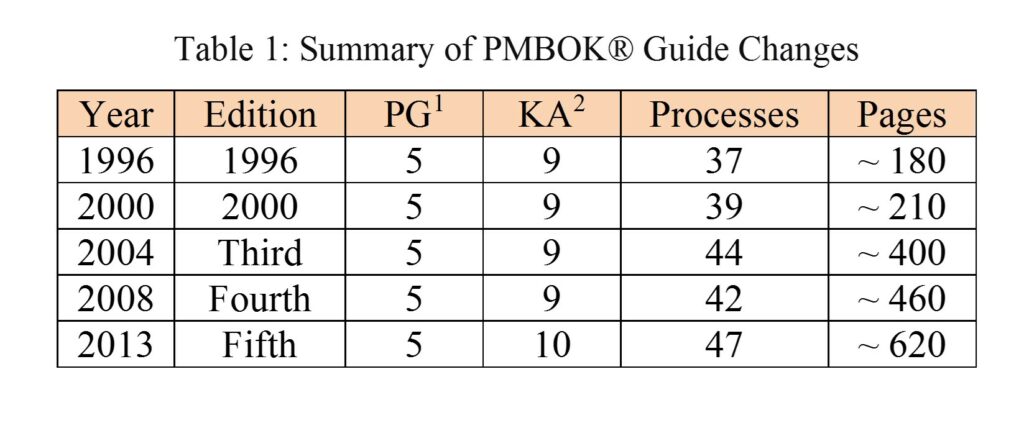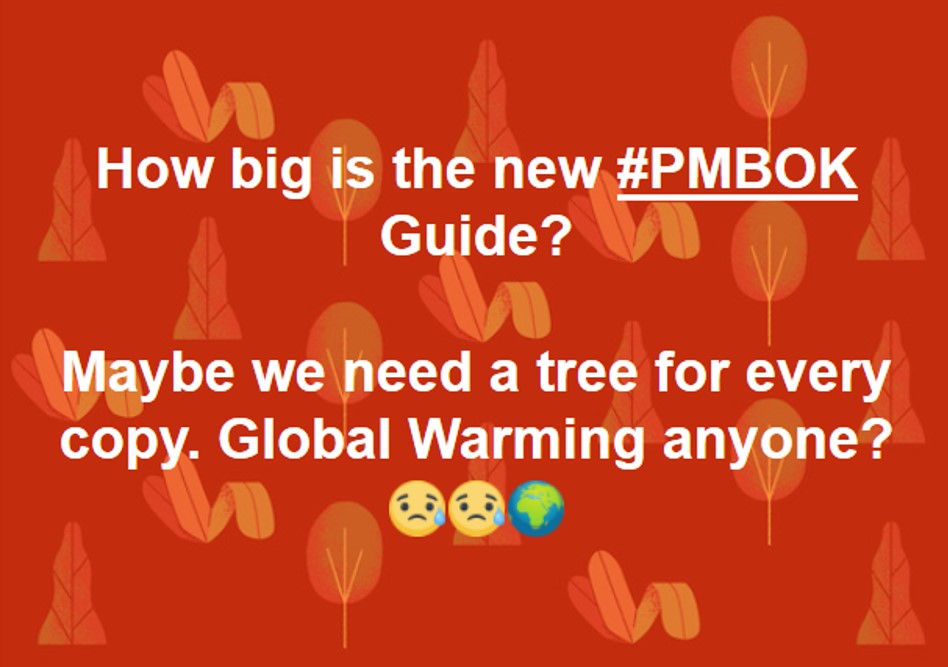With the recent release of the PMBOK Guide edition, I felt it is important to reflect back on something I wrote a long time ago and worth sharing again.
Before we move on to this article. This article focuses on the size of the guide not because we are interested in how many KG it weighs or how many pages but to answer a fundamental question: is the current size of the guide appropriate to its valuable content?
Then a related question: cannot we have the valuable information in the guide (all parts) transferred via 600 pages, 400 pages, or even a 200 pages document?
We can discuss content and specific topics in other blog posts.
Historical Perspective
Maybe the table below is a good historical reference for the first 5 editions

If we add a line for the sixth edition it would look like this:
| 2017 | Sixth | 5 | 10 | 49 | ~ 800 |
By the way, this is without the Agile Practice Guide
In other words, no changes in process groups or knowledge areas, 3 processes added and one deleted for a net change of 2 processes.
In other words, between the first edition and the sixth, the growth is more than 4 fold and even from the last edition – close to 200 pages of additional papers.
Are all of these pages necessary? Can we reduce the size without reducing the value?
How to Reduce the Size of the PMBOK Guide
Whitespace
The guide already includes a great deal of white space. In other words, the text covers only about 60 to 80% of most pages leaving 20 to 40% blank white space.
We believe just eliminating these unnecessary white spaces (the empty areas on pages) will probably be more than enough to cover additional content. There is no logical reason to start a new paragraph or part of a chapter on a new page. Only new chapters should start on new pages.
Remove redundancies
There are many topics that are mentioned several times, in almost identical terms, in different places. A solution for this would be a strict editor to remove these redundancies[1].
Separating the Standard from the Guide
This is related to the previous point of redundancies. Why not separate the ANSI Approved Standard and publish it as a standalone document like ISO 21500? This way, people can truly understand there are a standard and a guide instead of burying the standard as an annex.
Inputs – Tools & Techniques – Outputs
The guide’s current structure, covering all of the inputs – tools and techniques – and outputs has many repetitions; some of these could also be eliminated. However, we do not want to lose this content. There are two options to maintain the content.
Option 1: Practice standards
When the PMBOK® Guide was published in 1996, it was a single standard in the PMI library[2]. Therefore, covering all of the inputs – tools, and techniques – and outputs (ITTOs) might have been necessary. Today, PMI publishes a practice standard for every knowledge area, well almost. These practice standards have the same processes with their ITTOs.
Consequently, our recommendation would be:
- PMI to publish a few more practice standards to cover the topics that do not have practice standards now, and
- Remove all of the inputs – tools, and techniques – and outputs details from the PMBOK® Guide and putting them in the practice standard documents.
Option 2: Segregating ITTOs[3]
There are many common inputs and outputs can be grouped in an introductory chapter. Then, provide a table showing where each input-output is used.
Similarly, one can do the same for common tools, such as PMIS and expert judgment. Only provide the name of the tool in the knowledge area, and have a tools chapter at the end providing sufficient detail to understand the objective of the tool, but not how it works in detail.
Concluding Remarks
Honestly, I do not see the value of this many pages, especially that many people will buy hard copies or print their PDF copies. This is neither in line with the spirit of corporate social responsibility nor sustainability practices. If there is a need for this volume we can understand but what is the need?
Can anyone explain to us: is there really a huge/substantial / revolutionary/game-changing / etc. changes from the first edition to the sixth to justify adding more than 600 pages?
We have too many other comments but we reserve those to other posts. Will keep this one on size. The good news, maybe, if you bring copies of the guide to PMP classes you will get a good workout; no need for the gym that day.
[1] Idea from Mr. Crispin (“Kik”) Piney, PfMP, PgMP
[2] We realize there were other publications but as a standard, if we are not mistaken, it was the only one.
[3] Idea is also by Mr. Piney


Mounir, what PMI is finally beginning to discover is that you CANNOT parse the project management processes, roles and responsibilities associated with project management from those of Asset or Operations (program) management. This explains the “root cause” behind the growth of the PMBOK Guide.
This reality was made crystal clear by none other than Peter Drucker in his 1973 book “Management: Tasks, Responsibilities and Practices”. Drucker made the point that all applications of management need to be integrated.
This latest PMBOK Guide is STARTING to come around to the realization that there are three main “actors” in the play- Asset, Operations (Program) and Project managers and each has to play their appropriate role, and if one of them fails to play his/her role properly, both the project and the product of the project are at risk for failure. Max Wideman captured the very essence of this three way integrated roles and responsibilities way back in the late 1960’s- early 1970’s with Figure 2- http://www.planningplanet.com/guild/gpccar/introduction-to-managing-project-controls
BR,
Dr. PDG, Jakarta, Indonesia
Dr. Paul – IMHO your comments is out of context. Did you see or read the new guide? Where is the Asset Management content in the new guide that help the book grow by 200 (+/-) pages? I think at most, they have a small section with a few pages. In the standard section they have about 1 page only on benefits management, which could be considered linked to Asset Management but other than that ???